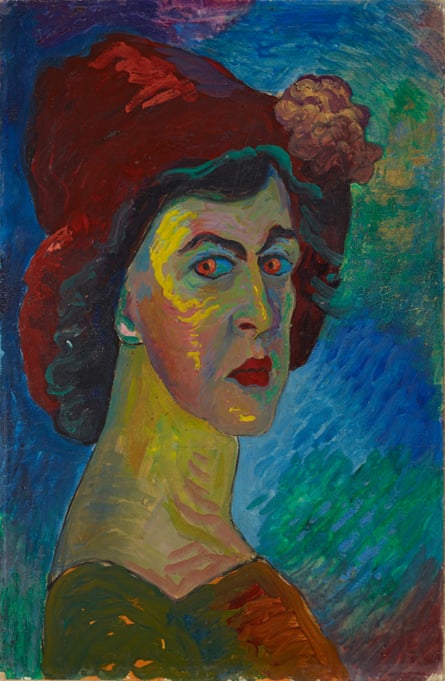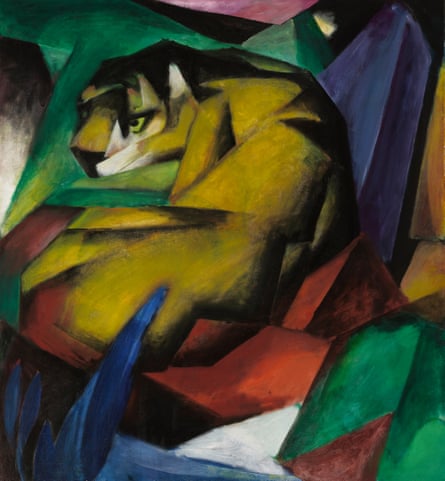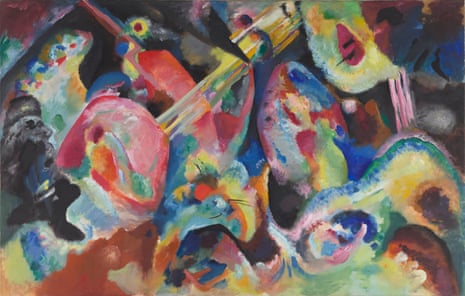Within the bright colours of this exhilarating survey of the Blue Rider group of avant garde artists, who worked in Munich and the Bavarian Alps in the years before the first world war, horror lurks. Look at Wassily Kandinsky’s paintings of the medieval Bavarian town Murnau, and you might wonder if there’s any connection with the film director FW Murnau who made the silent vampire film Nosferatu? Yes – he took the town’s name after befriending the Blue Rider artists there. So welcome to the land of spectres.
Marianne von Werefkin’s eyes, for instance, blaze red from her self-portrait. Green, yellow and pink duke it out for dominance of her skin. Her ochre hat with a violet flower collides with a swirling vortex of turquoise and sapphire sky. She’s an expressionist and no mistake.
Artists all over Europe were using colour subjectively when Werefkin painted her piercing self-image in about 1910. She appears to be referring to Henri Matisse’s 1905 painting Woman with a Hat, a sedate portrait of his wife which becomes a riot of arbitrary colours and a kaleidoscopic manifesto for the Fauvist movement. So what makes Werefkin an “expressionist” rather than a “fauve” ? The eyes have it. Gentle Matisse would never give someone red eyes with lurid implications of possession or satanism. Werefkin looks positively Nosferatu-like.

The Blue Rider artists communicate anxiety in their skins. The more beautiful their colours, the more queasy and unsettling. The French artist Robert Delaunay appeared in their show in Munich in 1911, but his paintings, dutifully included by Tate Modern, just point up how different modern art looked in Paris and Germany: Delaunay’s rational studies of pure colour lack the angst of the expressionists around him.
You can’t accuse Franz Marc’s painting Tiger of lacking angst. It is the essence of tigerdom, a snarling beast of a picture. The tiger curls its yellow and black body in a jungle of red and blue diamonds as Marc uncorks 100% proof colours and hacks them into shape with streaks of black.
Marc, one of the wildest-eyed geniuses of this exhibition, would die in the battle of Verdun in 1916, aged 36. You will be convinced it was the biggest artistic loss of the Great War. His empathy for the animal world is captivating. In the Rain shows busy Munich with a dog as its most sympathetic protagonist, a perplexed soul at the edge of the human cacophony.
That tiger though is the most powerful character in the show, a spirit of pure violence. It raises a crucial question about the expressionists’ relationship to the age of catastrophe unleashed in 1914 which would lead to nazism and the Holocaust. Writing in the ashes of Germany’s 20th century, in Dr Faustus the novelist Thomas Mann gets close to blaming expressionism for nazism.
Sure enough, as you look at Marc’s paintings you hear the dissonant, shuddering music of the terrible young century. In fact Marc and Kandinsky went to hear the music of Austrian expressionist Arnold Schoenberg in Munich. In one fascinating room, Schoenberg’s revolutionary noise (which inspired Mann’s expressionist composer antihero) is the soundtrack for Kandinsky’s painting Impression III (Concert). In it, the audience seem to be rushing the stage as reality melts into atonal blue and yellow: there’s even what looks like a machine gun. And if you want to argue that expressionism is full of premonitions of war and extremism, Kandinsky’s painting Impression Deluge is devastating evidence. Painted in 1913, it suggests Europeans could already feel in their bones the abyss that would open the following summer. Planets explode, suns die, in frothy fringes of blue fire and hairy tendrils brushing orange fleshy blooms. Kandinsky loves this apocalypse.

Yet this exhibition chooses to take a different view of expressionism. Far from a movement of isolated individuals pursuing their inner Germanic demons, the Blue Rider was a “transnational” network of artists whose loves and friendships crossed borders and genders. Werefkin was a member of the Russian nobility who moved to Germany to become an artist. Kandinsky, too, was Russian. He migrated to Munich in the 1890s to study art, met the artist Gabriele Münter, and they lived together in Murnau. The Blue Rider, as this exhibition has it, was a constellation of women and men revolving round Münter and Kandinsky.
At times it comes across like the Bloomsbury Group with better beer. Münter is the least “expressionist” artist here, if expressionism means being possessed by an inner tiger. Her paintings ground the social world of the Blue Rider, offering relaxed glimpses of Bavarian Bohemia. In her affectionate scene of Kandinsky and Erma Bossi at the Table, her lover sits in shorts and blue glasses holding forth over the coffee cups in a multicoloured room. What’s he going on about? The spiritual purpose of art, probably.
after newsletter promotion

Kandinsky’s theories about the spiritual in art and his voyage towards pure abstraction are here brilliantly located in his real world. Freed from being lofty monuments of modern art, his canvases become fresh as you see him experiment. His fantastic 1910 painting The Cow is a delirious transfiguration of the German countryside: a woman milks it in front of a riotous landscape of church steeples and dollops of hills, blissfully accepting its crazy yellow spots. Who knew Kandinsky could be funny?
Tate Modern presents the Blue Rider artists as pioneers of the liberal spirit of the Weimar Republic. Werefkin experimented with gender. Kandinsky would work in Weimar’s Bauhaus school.
And yet, the most exciting, drop dead moments are when these painters look into a void of horror and Wagnerian grandeur. When Werefkin paints a little church in the German Alps, its reassuring cosiness is dwarfed by those icy peaks with their deathly music of the sublime. In expressionism, the devil has all the best tunes.
Expressionists: Kandinsky, Münter and the Blue Rider is at Tate Modern, London, from 25 April to 20 October
This review was amended on 23 April to correct the title of Kandinsky’s painting The Cow. An earlier version called it Yellow Cow, which is the title of a Franz Marc painting from one year later

Comments (…)
Sign in or create your Guardian account to join the discussion